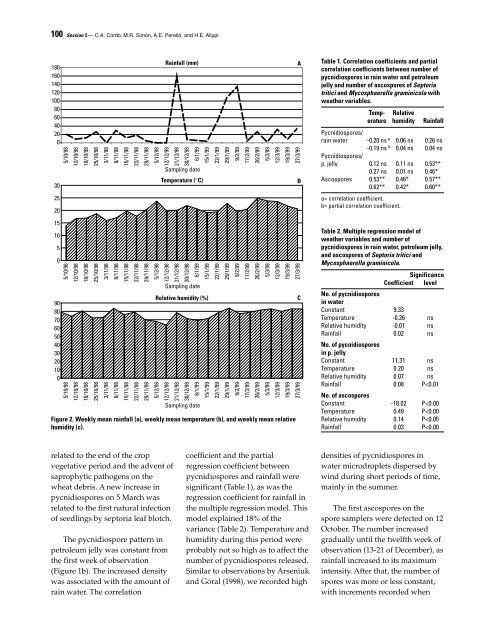Septoria and Stagonospora Diseases of Cereals - CIMMYT ...
Septoria and Stagonospora Diseases of Cereals - CIMMYT ...
Septoria and Stagonospora Diseases of Cereals - CIMMYT ...
You also want an ePaper? Increase the reach of your titles
YUMPU automatically turns print PDFs into web optimized ePapers that Google loves.
Session 5 — C.A. Cordo, M.R. Simón, A.E. Perelló, <strong>and</strong> H.E. Alippi<br />
100<br />
180<br />
160<br />
140<br />
120<br />
100<br />
80<br />
60<br />
40<br />
20<br />
0<br />
30<br />
25<br />
20<br />
15<br />
10<br />
5<br />
0<br />
90<br />
80<br />
70<br />
60<br />
50<br />
40<br />
30<br />
20<br />
10<br />
0<br />
5/10/98<br />
5/10/98<br />
5/10/98<br />
12/10/98<br />
18/10/98<br />
12/10/98<br />
18/10/98<br />
12/10/98<br />
18/10/98<br />
25/10/98<br />
3/11/98<br />
25/10/98<br />
3/11/98<br />
25/10/98<br />
3/11/98<br />
8/11/98<br />
8/11/98<br />
8/11/98<br />
15/11/98<br />
22/11/98<br />
15/11/98<br />
22/11/98<br />
15/11/98<br />
22/11/98<br />
29/11/98<br />
5/12/98<br />
29/11/98<br />
5/12/98<br />
29/11/98<br />
5/12/98<br />
Rainfall (mm)<br />
12/12/98<br />
21/12/98<br />
30/12/98<br />
6/1/99<br />
Sampling date<br />
Temperature (°C)<br />
12/12/98<br />
21/12/98<br />
30/12/98<br />
6/1/99<br />
Sampling date<br />
Relative humidity (%)<br />
12/12/98<br />
21/12/98<br />
30/12/98<br />
6/1/99<br />
Sampling date<br />
15/1/99<br />
22/1/99<br />
15/1/99<br />
22/1/99<br />
15/1/99<br />
22/1/99<br />
29/1/99<br />
9/2/99<br />
29/1/99<br />
9/2/99<br />
29/1/99<br />
9/2/99<br />
17/2/99<br />
26/2/99<br />
17/2/99<br />
26/2/99<br />
17/2/99<br />
26/2/99<br />
5/3/99<br />
5/3/99<br />
5/3/99<br />
12/3/99<br />
19/3/99<br />
12/3/99<br />
19/3/99<br />
12/3/99<br />
19/3/99<br />
Figure 2. Weekly mean rainfall (a), weekly mean temperature (b), <strong>and</strong> weekly mean relative<br />
humidity (c).<br />
related to the end <strong>of</strong> the crop<br />
vegetative period <strong>and</strong> the advent <strong>of</strong><br />
saprophytic pathogens on the<br />
wheat debris. A new increase in<br />
pycnidiospores on 5 March was<br />
related to the first natural infection<br />
<strong>of</strong> seedlings by septoria leaf blotch.<br />
The pycnidiospore pattern in<br />
petroleum jelly was constant from<br />
the first week <strong>of</strong> observation<br />
(Figure 1b). The increased density<br />
was associated with the amount <strong>of</strong><br />
rain water. The correlation<br />
A<br />
27/3/99<br />
B<br />
27/3/99<br />
C<br />
27/3/99<br />
coefficient <strong>and</strong> the partial<br />
regression coefficient between<br />
pycnidiospores <strong>and</strong> rainfall were<br />
significant (Table 1), as was the<br />
regression coefficient for rainfall in<br />
the multiple regression model. This<br />
model explained 18% <strong>of</strong> the<br />
variance (Table 2). Temperature <strong>and</strong><br />
humidity during this period were<br />
probably not so high as to affect the<br />
number <strong>of</strong> pycnidiospores released.<br />
Similar to observations by Arseniuk<br />
<strong>and</strong> Góral (1998), we recorded high<br />
Table 1. Correlation coefficients <strong>and</strong> partial<br />
correlation coefficients between number <strong>of</strong><br />
pycnidiospores in rain water <strong>and</strong> petroleum<br />
jelly <strong>and</strong> number <strong>of</strong> ascospores <strong>of</strong> <strong>Septoria</strong><br />
tritici <strong>and</strong> Mycosphaerella graminicola with<br />
weather variables.<br />
Temp- Relative<br />
erature humidity Rainfall<br />
Pycnidiospores/<br />
rain water -0.20 ns a 0.06 ns 0.26 ns<br />
-0.19 ns b 0.04 ns 0.04 ns<br />
Pycnidiospores/<br />
p. jelly 0.12 ns 0.11 ns 0.53**<br />
0.27 ns 0.01 ns 0.46*<br />
Ascospores 0.53** 0.46* 0.57**<br />
0.62** 0.42* 0.60**<br />
a= correlation coefficient.<br />
b= partial correlation coefficient.<br />
Table 2. Multiple regression model <strong>of</strong><br />
weather variables <strong>and</strong> number <strong>of</strong><br />
pycnidiospores in rain water, petroleum jelly,<br />
<strong>and</strong> ascospores <strong>of</strong> <strong>Septoria</strong> tritici <strong>and</strong><br />
Mycosphaerella graminicola.<br />
Significance<br />
Coefficient level<br />
No. <strong>of</strong> pycnidiospores<br />
in water<br />
Constant 9.33<br />
Temperature -0.26 ns<br />
Relative humidity -0.01 ns<br />
Rainfall<br />
No. <strong>of</strong> pycnidiospores<br />
in p. jelly<br />
0.02 ns<br />
Constant 11.31 ns<br />
Temperature 0.20 ns<br />
Relative humidity 0.07 ns<br />
Rainfall<br />
No. <strong>of</strong> ascospores<br />
0.08 P









